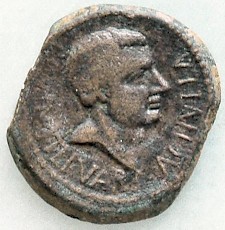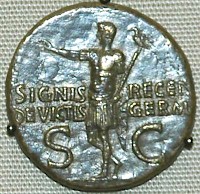Legio XVII
Legio XVII: one of the Roman legions. Its surname is not known, but may have been Gallica or Germanica.

Due to the fact that they were destroyed in the battle in the Teutoburg Forest in September 9, the history of the legions XVII, XVIII and XIX is not well understood. Except for one highly ambiguous inscription that has to be read backwards (below), the Seventeenth is not even known from texts, and is therefore among Rome's most mysterious military units. The existence of a seventeenth legion in the Augustan army is in fact a hypothesis. However, the arguments for this hypothesis are strong enough:
- The legions of the Augustan army were numbered from one to twenty-two. It would have been strange if there was no seventeenth legion.
- During the battle in the Teutoburg Forest, three legions were destroyed. Among them were the Eighteenth and Nineteenth. No other unit disappears from the archaeological-historical record at this moment, which makes it plausible that the third legion was a little-known unit, for example the Seventeenth.
- Finally, several seventeenth legions are known from the age of the civil wars.
During the civil war of 49-48, both Julius Caesar and Pompey the Great employed legions with the numbers XVII, XVIII and XIX, but we do not know what became of them. It has been argued that the Caesarian legions, commanded by Curio, were destroyed in Africa, but this is entirely hypothetical.
It is more probable that the Seventeenth was founded in 41 or 40 BCE, after the battle of Philippi (where Caesar's murderers Brutus and Cassius were defeated). Its founder must have been Caesar's heir Octavian, who needed new units to put an end to Sextus Pompeius' occupation of Sicily, which put the grain supply of Rome into peril. The first generation of soldiers may have consisted of veterans of the army of Brutus and Cassius; others may have been recruited in northern Italy, because this is where most soldiers of the legions XVIII and XIX came from.
When Pompeius was defeated, Octavian and his fellow-triumvir Mark Antony fell out with each other and started a war, which culminated in the naval battle off Actium (31), where Octavian defeated his opponent and won the supremacy in the Mediterranean world. From now on, he was known as the emperor Augustus.
The possibility that the seventeenth legion is identical to the seventeenth legion Classica ("naval") of MarkAntony, cannot be excluded, but is less likely than the theory that this unit was founded by Octavian.
It is possible, but again hypothetical, that the Seventeenth was stationed in Aquitania during the fifteen years after the battle off Actium. An inscription showing the sign IIVX, found at Ehl in the Alsace, may or may not suggest that the Seventeenth stayed on the Middle Rhine. Later, it was almost certainly transferred to the Lower Rhine, together with XVI Gallica and the eighteenth legion.

In Germania, the soldiers took part in the campaigns in Germania of Augustus' generals Drusus (13-9) and Tiberius (8 BCE and 4-5 CE). In those years, the seventeenth legion was probably based at Xanten and/or Oberaden and/or Haltern. In 5, the conquest was completed and Augustus sent Publius Quinctilius Varus to rule the area as a governor, impose tribute and establish civil rule.
In 6 CE, Tiberius was to lead at least eight legions (VIII Augusta from Pannonia, XV Apollinaris and XX Valeria Victrix from Illyricum, XXI Rapax from Raetia, XIII Gemina, XIV Gemina and XVI Gallica from Germania Superior and an unknown unit) against king Maroboduus of the Marcomanni in Czechia; at the same time, I Germanica, V Alaudae, XVII, XVIII and XIX were to move against Czechia as well, attacking it along the Elbe. It was to be the most grandiose operation that was ever conducted by a Roman army, but a rebellion in Pannonia obstructed its execution.

It took three years to suppress the revolt. In these years, the Seventeenth was still with Varus. In September 9, however, the Cheruscan leader Arminius, one of Rome's most loyal allies, turned himself against the governor. When reports arrived that a western tribe had revolted, Varus, unaware of Arminius' treason, followed his advise to return to the Rhine. His army was trapped in the neighborhood of Osnabrück, in the Teutoburg Forest. The seventeenth, eighteenth and nineteenth legions were completely destroyed. The three eagle standards were recovered during the reigns of Tiberius (by Germanicus) and Caligula.
The legionary emblem of legion XVII is not known.
Literature
- R. Wiegels, "Legiones XVII, XVIII, XIX", in: Yann Le Bohec, Les légions de Rome sous le Haut-Empire (2000 Lyon) 75-8